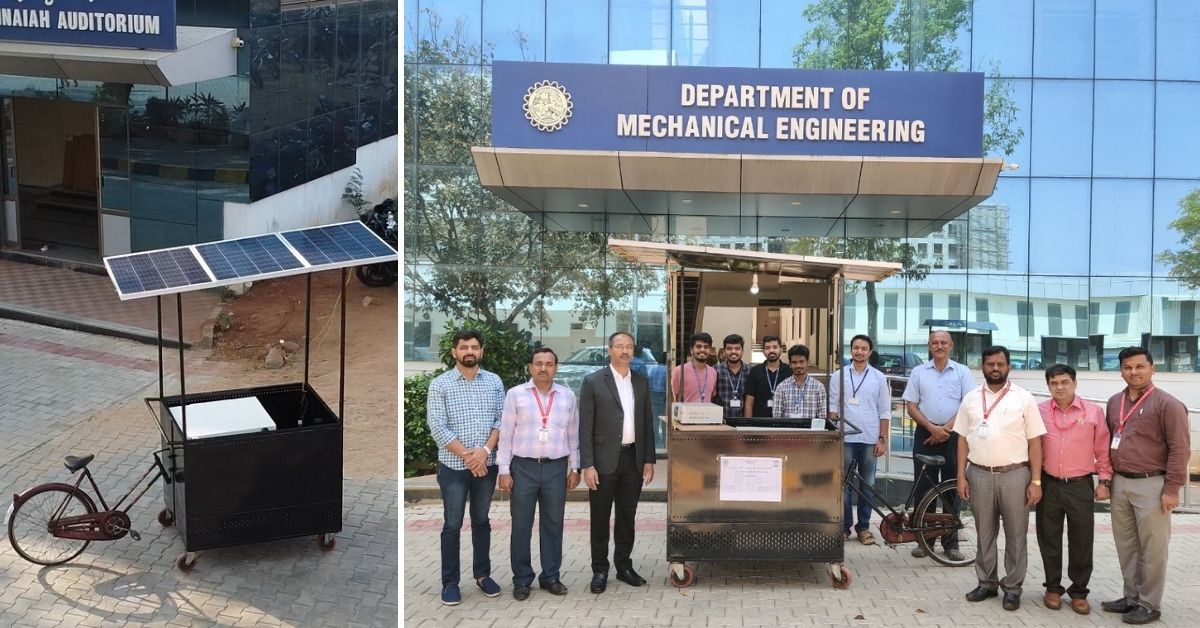Having grown up in a family engaged in agriculture, Naveen HV from Mandya, Karnataka, was always privy to the hardships faced by farmers. He also had in-depth knowledge of the whole supply chain — from when the produce was first sent to the market or vendors to when it eventually reached the customers.
This knowledge would eventually inspire him and his college friends to come up with an innovative solution to tackle a major struggle faced by vegetable vendors – keeping their perishable products fresh for longer periods of time.
Naveen and his batchmates Shubham Sain, Supreeth S and Vivek Chandrashekhar, who studied together at the Vidyavardhaka College of Engineering, Mysuru, have recently developed a low-cost solar cooling cart exclusively for the street vegetable vendors.
The innovation first came to life while the group was taking part in a competition conducted by the Indian Society of Heating, Refrigerating and Air Conditioning (ISHRAE).
To understand the major problems faced by vegetable vendors every day, the team carried out field research. “They usually keep their products in an open space, so there is always the issue of hygiene. But storage is the biggest challenge. We also took suggestions from our professors, and experts, and visited several industries before coming up with a feasible solution for the issue,” elaborates Naveen, who is in the sixth semester of Mechanical Engineering.

The cart developed by Naveen and his team has an air-cooled chamber that runs using solar energy for electricity. “The current model needs to be charged once a day at home, and after that, it runs on solar energy making it self-reliant. So, when the battery drains out, the solar energy generates electricity, which recharges the battery. It is similar to the working of a solar inverter. Higher capacity solar panels can be used, but we have restricted it to 150 Watts in order to make it cost-effective,” he explains.
Usually, a temperature of 5 to 10 degrees celsius is required to keep the vegetables fresh, says Naveen. “We have tried to extend the utility of the cart in a way that it can keep not only the vegetables or fruits but also dairy products fresh for longer. For that, we have set the temperature in the cart between 0 and 10 degrees Celsius.”
The highlight of the innovation is the low cost, Naveen says. Each cart is expected to cost around Rs 52,000. “Currently, the existing carts with cooling chambers cost over Rs 1 lakh, but our model cost only half the price,” says assistant professor NP Muthuraj from the Department of Mechanical Engineering, who guided the team in the project.
Talking about the challenges faced while building the cart, Supreeth S, another team member says, “We did the project in very less time during our fifth-semester exams. Managing the project work with the examinations was challenging, but we did learn a lot from the entire experience. Also, the project came out better than we expected.”
Going forward, the team is trying to improve the functioning and performance of the model to make it more efficient. “We are planning to replace the smaller wheels with bigger ones, which will make it easier for the person who pedals it. We are also trying to make it more energy-efficient by making it an electric vehicle by adding more solar panels,” explains Supreeth.
According to Naveen, the cooling solar cart works exactly like a refrigerator and can keep the vegetables fresh approximately for 7 to 10 days. He adds, “Our model needs a few more modifications, after which it could be made even cheaper through mass production, thereby making it easier for the vendors to afford it.”
(Edited by Divya Sethu)
If you found our stories insightful, informative, or even just enjoyable, we invite you to consider making a voluntary payment to support the work we do at The Better India. Your contribution helps us continue producing quality content that educates, inspires, and drives positive change.
Choose one of the payment options below for your contribution-
By paying for the stories you value, you directly contribute to sustaining our efforts focused on making a difference in the world. Together, let's ensure that impactful stories continue to be told and shared, enriching lives and communities alike.
Thank you for your support. Here are some frequently asked questions you might find helpful to know why you are contributing?

